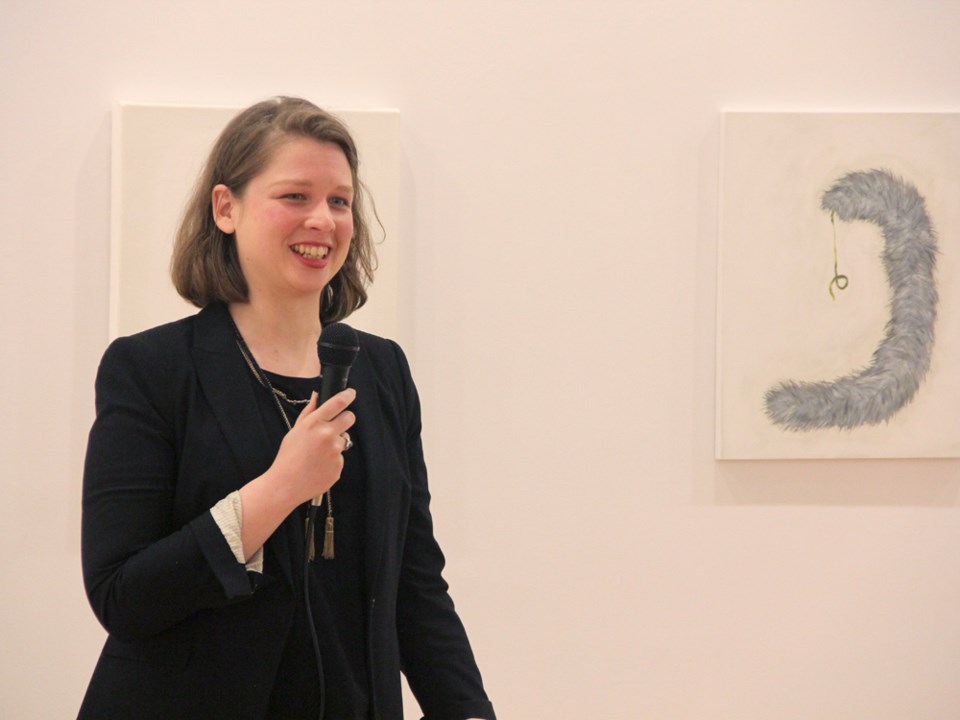What winter does to our bodies is often uncomfortable, and according to one artist, it’s downright violent.
Erica Mendritzki’s Snowed In and Felt Up is an ode to winter, looking at how people are inwardly affected by the outward experience of the bitter Winnipeg cold. Mendritzki spoke at an opening reception at the Estevan Art Gallery and Museum on March 19 to discuss the exhibit, which runs until May 8.
Without a car, Mendritzki does a lot of walking to the bus stop and waiting. The winter doesn’t make that a particularly pleasant experience. She shared a brief poem with the audience of about 25, and said the piece about braving the wintry air was an experience with which she was familiar.
“I can really relate to this idea of a girl walking with her head down. The body kind of huddled into herself, shaking with winter, trying to hide from the cold,” Mendritzki said, adding it’s the mental space of the woman she was often trying to evoke in her numerous pieces.
The exhibit includes hanged paintings depicting abstract body parts and words, while also including a scattering of goods, like cherubs and pipes on the floor.
“In winter, when I’m walking to the bus, when I’m outside, of course, I am in public, but I find I can retreat into myself in a way that is very different than in summer,” she said. Her head is down to avoid the wind, so she isn’t looking at anyone, and it’s often so cold that she may zone out mentally, and when she finally arrives at the bus stop she doesn’t really remember anything about how she got there.
Simply surviving the cold, she added, is the mentality of many pedestrians across the prairies.
“It’s a very inward-looking psychological state. It’s an interior mental state that’s caused by exterior conditions, which is the total unignorable, unavoidable brutality of the cold,” said Mendritzki. “In winter, the fact that we live in these vulnerable, fragile bodies becomes that much more evident. I think that there’s something kind of scary and hurtful and absurd, and maybe even a little bit exhilarating about the fact that in the middle of winter, the world wants to freeze your face off and kill you,” she told the audience, getting a laugh from the crowd. “It’s this ambient violence of life in climates as cold as this.”
Even for those who are careful, swaddling themselves up in layers of clothing, there are still parts of the body that wind up getting numb and aching with the cold. She said no matter what she does, her thighs tend to get particularly cold following any prolonged exposure to the outdoors. Upon getting back inside to the warmth, there follows the fiery sensations.
“There are a lot of weird bodily sensations happening. This combination of this intense physicality, this very embodied feeling, with this sheltered, huddled up mental space is something I’m interested in exploring,” Mendritzki said.
Her thoughts on the strangeness of the body are evident in the disembodied facets of her work. Hands hanging, detached from any body, a face floating in a void or an arm reaching out all show various parts of the body as singular entities separate from any sense of a whole.
The sculptures across the floor, meanwhile, are representative of what is beneath the snow, left unseen until the spring when artifacts are found once again following a melt. In the spring, Mendritzki said, she will often find things on her lawn that don’t belong to her, that she doesn’t recall ever being on her lawn before, but her hidden, living a life beneath the surface for months before being uncovered by the changing of the seasons.
“I’m not from Winnipeg, but I’ve lived there for the last three years, and, in some ways, this exhibition is kind of a coming to terms of a sense of place, trying to be there in that moment at the end of March when you’re starting to go a little stir crazy. The floor sculptures are like when the snow starts to melt, there is detritus everywhere. There are these unexpected things. Here is a weird conglomeration of stuff on my lawn,” she said, with a laugh.
An essay by curator Alex King noted that to view the paintings on the wall, viewers must navigate the objects on the floor.
“This forces the viewer to look and tread with caution, replicating the care one takes walking on frosty streets,” the essay reads.




